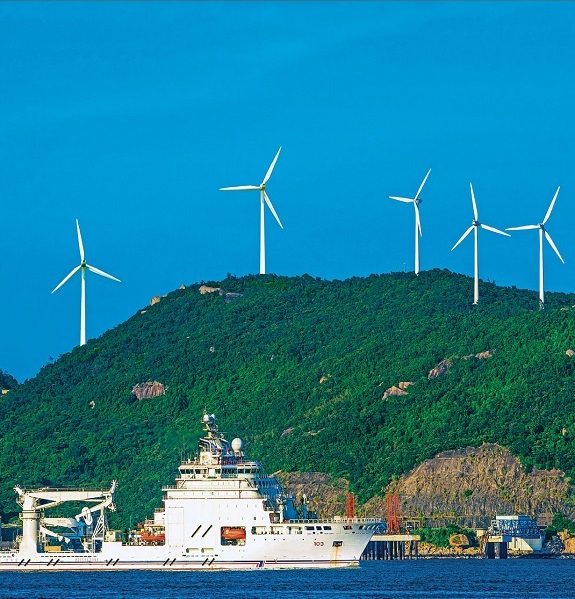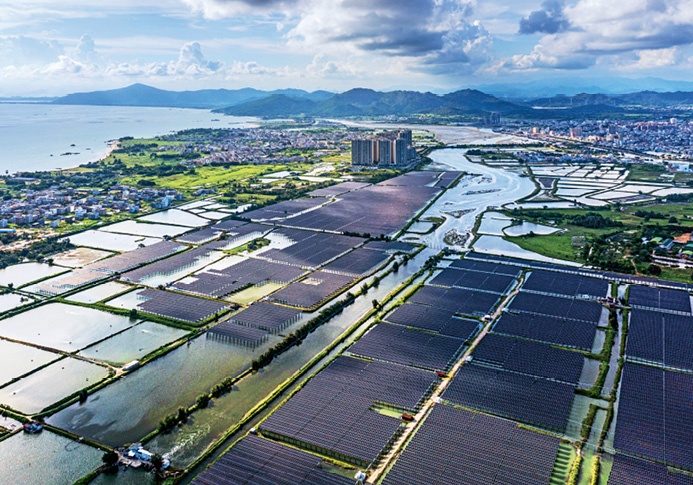The GBA’s Outline Development Plan targets new energy development as an essential requirement going forward.

A clear day at the Guishan Offshore Wind Farm in Zhuhai, Guangdong Province.
Optimizing the energy structure of the Guangdong-Hong Kong-Macao Greater Bay Area (GBA) and building a clean, low-carbon, safe, and efficient energy supply system is a priority set in the GBA’s Outline Development Plan. Over the past few years, the new energy industry has flourished, becoming a distinct hallmark of its development.
Green Momentum
As of 2024, the new energy industry has become the ninth trillion yuan industrial cluster in Guangdong Province, and the offshore wind power industry has played a significant role in this development. By the end of 2024, the province’s total installed capacity of offshore wind power had surpassed 12 million kilowatts.
Located at the convergence of three strategic regions — the GBA, the Beibu Gulf urban cluster, and the Hainan Free Trade Port, Yangjiang City possesses exceptional natural resources. It has established one of China’s largest industrial clusters for wind power equipment manufacturing, with the installed capacity ranking among the top in the country.
Meanwhile, nuclear energy has not been neglected. About 50 kilometers northeast of Hong Kong, the Daya Bay Nuclear Power Plant was put into operation back in 1994 — the first large-scale commercial nuclear power unit in China’s mainland. Guangdong was one of the first provinces in China to develop nuclear power. Currently, the total installed capacity of six nuclear power units at the Daya Bay base exceeds 6.12 million kilowatts, making it one of the largest pressurized water reactor nuclear power bases in the world. As of December 31, 2024, the plant has generated a cumulative on-grid energy output of 984.67 billion kilowatt-hours, reducing over 800 million tons of carbon dioxide emissions. The environmental benefits are equivalent to approximately 2.22 million hectares of afforestation. The plant plays a positive role in power supply and low-carbon energy transformation for the GBA.
Guangdong, after 30 years of development, has established several nuclear power plants, including Daya Bay, Ling’ao, and Yangjiang. It currently operates 14 nuclear power units with an installed capacity of 16.14 million kilowatts, ranking first in China.
With its vigorous promotion of green energy, Guangdong is focusing on the development of new energy vehicles and emerging energy storage industries. Currently, its new energy industry has reached target scale ahead of schedule, with wind energy, solar energy, and biomass energy achieving large-scale application.
Along with the installed capacity of nuclear power and the reserve capacity of natural gas leading the country, offshore wind power has also entered a fast development phase. The green momentum of this economically powerful province is definitely on the rise.
Economy and Ecology
In recent years, the intertwining of green development and the marine economy in Guangdong has yielded both economic and ecological benefits.
Liquefied natural gas (LNG) is recognized as the cleanest fossil energy source on Earth. As a major energy-consuming province, increasing natural gas’ proportion in primary energy consumption is a significant measure for Guangdong to optimize its energy structure and build a clean, low-carbon, safe, and efficient modern energy system.
Guangdong Dapeng LNG terminal, the first such terminal in China, has been operational since 2006. Two rows of blue tanks are neatly arranged inside the terminal, housing lobsters, abalone, and other aquatic products. Using cold energy from LNG to cultivate seafood has become a reality from a once seemingly wild idea.
For many lucrative aquatic products, the higher seawater temperatures in the southern regions are not suitable for their survival. Meanwhile, the huge amount of cold energy generated each year during the LNG regasification process at the terminal is wasted.
The terminal subsequently established the country's first LNG cold energy aquaculture demonstration project, turning waste into treasure. This project utilizes cold energy to lower the seawater temperature, creating a circulating flowing aquaculture system. The first batch of aquatic products was harvested on January 18, 2025, with an expected annual output of up to 50,000 kilograms. The products are sold at market for over RMB 100 per kilogram, while the overall costs of production have been reduced by 30 percent, resulting in significant financial benefits.
The wind power industry has also made major progress in integrated development. The world's largest typhoon-resistant wind power-fishery integrated platform, the Fuxi No.1 by China General Nuclear Power Corporation, was put into operation in Shanwei, Guangdong Province in September 2024. The project, designed to withstand super typhoons of up to Category 17, is expected to generate an annual output value of RMB 54 million upon full production, serving as an important demonstration for the integrated development of China’s “offshore wind power + marine ranching” industry.
Shanwei boasts a maritime area of 23,900 square kilometers, with an annual fishery output value consistently ranking among the top in Guangdong. It is an important fishing ground in the South China Sea, and has a solid foundation for the development of modern marine ranching. Leveraging the demonstration effect of the Fuxi No. 1 project, Shanwei will construct a modern marine ranching comprehensive demonstration zone with a total investment of RMB 3.1 billion and annual output value of RMB 1.36 billion. Meanwhile, a comprehensive fishery tourism platform will also be promoted, with the anticipated annual output value exceeding RMB 80 million.

A fishery-photovoltaic power station in Shanwei, Guangdong Province.
Interregional Cooperation
Guangdong, Hong Kong, and Macao each has its own unique advantages. It is only through coordination and cooperation in the adjustment of energy structures that green development can be reached.
In the process of achieving carbon peaking and carbon neutrality goals, Hong Kong has taken the lead. The secretary for Environment and Ecology of the Hong Kong Special Administrative Region, Tse Chin Wan, stated that Hong Kong achieved its carbon peak in 2014 and has maintained a downward trend over the past decade.
Electricity generation is the largest source of carbon emissions in Hong Kong, accounting for approximately two-thirds of its total emissions. To ensure the achievement of carbon neutrality by 2050, Hong Kong has established the Hong Kong Climate Action Blueprint 2050, which aims to strengthen cross-regional power transmission infrastructure and increase the proportion of zero-carbon energy used in electricity generation, ultimately achieving net-zero electricity generation by 2050.
During the 14th Five-Year Plan period (2021-2025), the interconnectivity of electric power infrastructure between Guangdong and Hong Kong has continued to improve, with the maximum power transmission capacity to Hong Kong increasing from 1.8 million kilowatts to 2.7 million kilowatts.
One important measure of net-zero electricity generation is to replace coal with low-emission fossil fuels such as natural gas. China National Offshore Oil Corporation (CNOOC) is a major natural gas supplier in the GBA. Primarily using the submarine gas pipeline built in the 1990s, CNOOC continuously supplies natural gas to Hong Kong, holding a 68-percent market share in the Hong Kong natural gas market.
In 2008, the Hengqin-Macao Natural Gas Pipeline marked the end of Macao’s dependence on heavy fuel oil for generating electricity, with CNOOC becoming the sole gas supplier for Macao. The GBA hence achieved full coverage of clean energy. In April 2023, the gas supply pipeline was extended to the Guangdong-Macao In-Depth Cooperation Zone in Hengqin, further contributing to the construction of the beautiful bay area. As of the end of April 2023, CNOOC has supplied over 70 billion cubic meters of natural gas to Hong Kong and Macao.The Guangdong-Macau interconnection was officially launched in 1984. In 2022, the completion of a 220-kilowatt substation provided a triple guarantee for stable, green, and efficient power supply to Macao. In July 2024, the electricity load supplied from the Chinese mainland to Macao exceeded one million kilowatts for the first time, setting a new historical record.
The power companies from both regions have established a series of efficient communication and coordination mechanisms to ensure the timely resolution of various issues, thereby safeguarding the safety and stability of electricity supply to Macao.
Cities located in the GBA are advancing together on the path of green development, fostering greater integration. Guangdong issued RMB 2 billion of offshore government bonds in Macao on August 31, 2023, among which the three-year special bonds are green bonds, and the funds raised are used for sewage treatment projects in Guangzhou. Two months later, the China Emissions Exchange Shenzhen signed a memorandum of cooperation with Hong Kong Exchanges and Clearing Limited to carry out collaborative efforts for the connectivity of carbon markets in both regions, and to explore new models for climate-related investment and financing.
Hong Kong and Macao are highly dependent on energy imports. It is crucial to seek a balance between maintaining supply stability, controlling prices, and achieving green development, while deepening energy cooperation with the mainland. At this year’s “two sessions,” Kevin Ho King-lun, president of the Industry and Commerce Association of Macao and a deputy to the National People’s Congress, put forward a suggestion for Guangdong and Macao to collaborate in the following aspects: building a new system for coordinated energy supply; exploring integrated innovative models of marine economy and green energy; creating a green finance and international exchange platform to enhance Macao’s global influence in the green economy; attracting international capital and technology to support Macao in becoming a benchmark city for the international green economy; innovating policy coordination mechanisms and improving the supporting system for cross-border green electricity development.
The Hong Kong government released its hydrogen development plan in June 2024, announcing to transform Hong Kong into a demonstration base for the national development of hydrogen energy. Nanhai District in Foshan, a hydrogen industry hub of China, is Hong Kong's preferred partner.
Currently, the GBA is actively preparing a memorandum of cooperation on the development of hydrogen energy, establishing a collaborative mechanism and exploring cooperation in nine key areas. A hydrogen industry promotion fair was held in Hong Kong on March 12, 2025. Multiple projects were signed, including a framework agreement for the promotion of hydrogen-powered vehicles and an agreement for the demonstration project of cross-border transportation by hydrogen logistics vehicles. This marks a big step forward in the cooperation between Nanhai and Hong Kong in the field of hydrogen energy.
It is projected that the GBA’s vision of new energy collaboration will become a reality in the future.